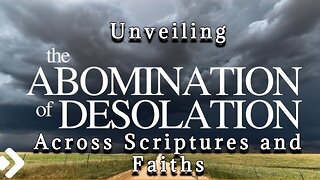Decoding the Secrets f How We Determine the Seven-Year Tribulation
The Tribulation is a profound and foreboding in the unfolding narrative of God's divine plan. This future seven-year period serves as a crucible for His ultimate discipline of Israel and the culmination of His judgment upon the unbelieving world. It's a time when the church, comprised of those who have unwaveringly placed their faith in the Lord Jesus, will be conspicuously absent, having been ushered away in a cataclysmic event known as the Rapture, as foretold in passages like 1 Thessalonians 4:13–18 and 1 Corinthians 15:51–53. This divine provision ensures the church's exemption from the impending wrath (1 Thessalonians 5:9).
Throughout the tapestry of sacred scripture, this period of tribulation is intricately woven into the fabric of the "day of the Lord." This day is when God personally intervenes in human history to execute His divine plan, a theme resonating in passages such as Isaiah 2:12, 13:6–9, Joel 1:15, 2:1–31, 3:14, and 1 Thessalonians 5:2. It is referred to as "tribulation... in the latter days" (Deuteronomy 4:30, ESV), the "great tribulation" signifying the intensified second half of the seven-year period (Matthew 24:21), "a time of distress" (Daniel 12:1), and "the time of Jacob's trouble" (Jeremiah 30:7, NKJV). Zephaniah 1:15–16 vividly paints the tribulation as "a day of wrath—a day of distress and anguish, a day of trouble and ruin, a day of darkness and gloom, a day of clouds and blackness—a day of trumpet and battle cry."
The tribulation is characterized by an array of divine judgments, celestial disturbances, natural disasters, and dreadful plagues, as vividly depicted in the pages of Revelation 6–16. God, in His infinite compassion, places a limit on the tribulation's duration. As Jesus Himself attested, "Those will be days of distress unparalleled from the beginning, when God created the world, to the present, and never to be surpassed again. No one would have survived had the Lord not shortened those days" (Mark 13:19–20).
Delving further into the heart of this eschatological framework, we turn to Daniel 9:24–27. In this pivotal passage, the purpose and duration of the tribulation are unveiled. The context of "seventy weeks" pertains to "your people," which unequivocally refers to the Jews, the nation of Israel. Daniel 9:24 outlines God's intent: "to finish transgression, to put an end to sin, to atone for wickedness, to bring in everlasting righteousness, to seal up vision and prophecy, and to anoint the most holy." Astonishingly, it is decreed that these monumental purposes will be accomplished within "seventy sevens," where "sevens" signify clusters of years, equating to 490 years (or seventy "weeks" of years in some translations).
Daniel 9:25 and 26 provide further insight, pinpointing the Messiah's demise after "seven sevens and sixty-two sevens" (a total of 69 sevens or 483 years) from the decree to rebuild Jerusalem. Historical records validate that precisely 483 years elapsed between the issuance of the decree and Jesus' crucifixion. Notably, most Christian scholars, regardless of their eschatological views, concur with this interpretation of Daniel's 70 sevens.
Remarkably, God declared a total of 70 weeks (490 years), but only 69 weeks are accounted for up to the Messiah's death. This enigmatic detail leaves one seven-year period unaccounted for, which is none other than the Tribulation. It is during this final seven-year stretch that God's judgment upon Israel reaches its culmination, leading to their ultimate restoration to Him.
-
 4:30
4:30
RoxNolin1
10 months agoWhat is the difference between the tribulation and the Great tribulation
4831 -
 5:51
5:51
The History Speaks (Books Reader)
9 months agoUnveiling the Abomination of Desolation: Shocking Discoveries
416 -
 20:32
20:32
StillSmallVoice
2 years ago $0.07 earnedSecret Rapture 3 Days of Darkness, Our Discernment Process, True or False?
711 -
 2:26:32
2:26:32
For His Glory TX
3 months ago🔥 AN OVERVIEW OF THE BOOK OF REVELATION (PART 9) REVELATION CHAPTER 18 🔥
66 -
 1:03
1:03
BiblePropheciesBookofRevelation
2 years ago $0.01 earnedMost hidden Secrets of the Bible - Amazing Revelation
216 -
 1:03
1:03
BiblePropheciesBookofRevelation
2 years ago $0.07 earnedThe Seventh Trumpet and Secrets of the Book of Revelation
987 -
 55:55
55:55
jimmoore777
11 months ago|| THE TWO FINAL HARVESTS OF THE LAST DAYS || TAKEN FROM REVELATION FOURTEEN ||
2271 -
 10:11
10:11
Jesus' Love Letters ... Liebesbriefe
3 months agoThe coming Tribulation… This is My Advice for the Left Behind ❤️ Love Letter from Jesus Christ
126 -
 1:03
1:03
BiblePropheciesBookofRevelation
2 years ago $0.01 earnedBOOK OF REVELATION: Secret Chronology of the Sixth Trumpet
422 -
 40:36
40:36
MorielTV Rumble
5 months ago📖 Unlocking Secrets of Ruth: A Bible Study | From Famine to Redemption
1.35K1